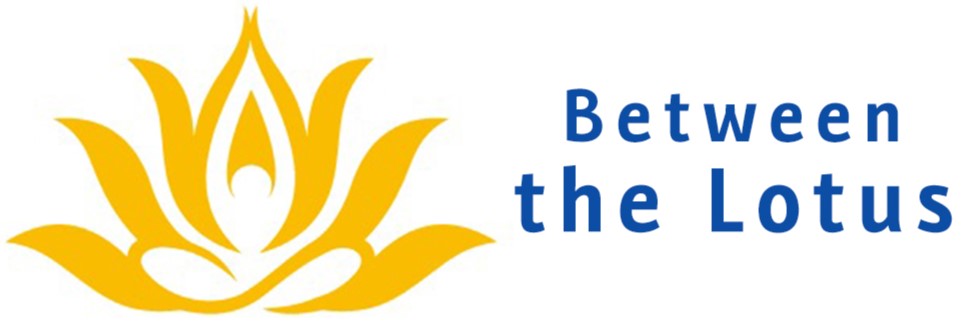Why Yoga and Stress Management?
94% of working Americans report feeling stressed at work. Even outside of the working class, 76% of the total US adult population experience health impacts due to stress. This includes headaches, fatigue, anxiety, and depression.
The rest of the world is not far behind:
- 74% of the UK population is so stressed that they are unable to cope.
- 5 of 10 Australians are experiencing “a lot of stress” at work.
- 35% of the entire world population is under stress!
And get this, despite a revolution in the domain of medical science in recent years, it has no cure for stress.
Enter Yoga.
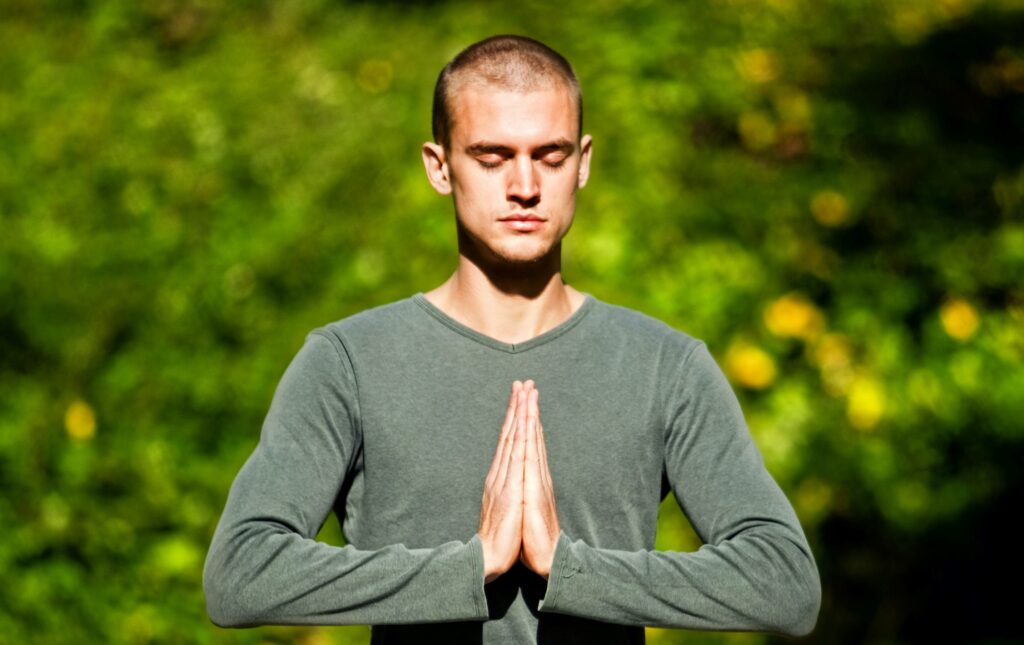
According to scientific research, the best ways to cope with stress are nothing but the foundational principles of the ancient Yogic science of India:
- A plant-based diet called the Sattvik diet in the Yogic science
- Stretching of the muscles while using the breath correctly – the fundamental for Asanas
- Breathing exercises called the Pranayama, and
- Meditation
This article will talk at length about each of these, as well as the type of Yoga you should practice to get the maximum stress relief.
Table of Contents
But first, let us see some research papers on Yoga and its impact on stress. Here we go!
Yoga and stress management case study
Let’s take a look at diverse case studies to measure the effect of stress on different demographics.
To measure the effects of Yoga on women, a specialist conducted Hatha yoga sessions for 4 weeks (3 times per week weeks for 60-70 min each). After the sessions, there was a significant decrease in their depression, anxiety, and stress levels.
A similar study done with pregnant women also showed positive results.
There are many studies on workplace stress, including healthcare workers who have one of the most demanding nature of the job. Working in shifts, long working hours, and coping with the emotional challenges of the job cause constant stress
Studies conducted on the healthcare industry showed:
- Yoga programs are more effective than cognitive training in determining better mental well-being and reduction of stress-related consequences.
- Yoga and meditation can help healthcare workers achieve stable mental and physical well-being.
- Yoga is effective in the prevention and management of musculoskeletal and psychological issues.
- The quality of sleep improved, and stress levels and burnout were consistently reduced in subjects who practiced yoga techniques and mind-body meditation.
- Chinese nurses showed improvement in stress levels, following a six-month yoga program.
- Medical students showed improvement in self-regulation and self-compassion after an 11-week yoga program.

So, it will be logical to say that Yoga is an effective tool for stress relief in other professions too.
With 63% of Americans ready to quit their jobs to avoid stress and 67% of Australians ‘quiet quitting’, we are sitting on a ticking time bomb. More companies should come forward to include Yoga in their employee wellness programs.
Studies done on teenagers and other age school students revealed:
- New Orleans – Significant improvement in psychosocial and emotional quality of life
- Massachusetts – Improved academic & athletic performance, reduced reactivity to stressful social situations. Findings support yoga’s potential to improve mental health at the individual level.
- New York – Decreased alcohol use, a significant increase in social skills, and an increase in attention during a stressful task.
- California – Enhanced emotion regulation that can serve as a protective factor against the onset & progression of mental health.
- These groups included both male and female students and so, Yoga is equally beneficial for male and female students.
A study measuring the effect of Yoga on male patients with Insomnia showed significantly better stress scores and self-confidence scores after eight weeks of yoga therapy.
Also, a study by Deakin University has found significant mental and physical health benefits for men who practice yoga. The biggest challenge though for men in joining a Yoga class is having the courage to join it.
It is because of its wrong portrayal as a body sculpting and flexibility practice, that men look at Yoga as a women’s thing. It is high time this image changes and people realize that Yoga is way more than that.
Various studies have also shown positive effects of Yoga on issues like:
- Mental health conditions
- Multiple sclerosis
- Asthma
- Irritable bowel syndrome
- Lymphoma
- Hypertension
- Drug addiction, and
- Osteoarthritis
All these conditions cause stress to a big part of the global population, and Yoga offers a solution.
How does Yoga help in stress management – 8 outstanding benefits!
#1. Yoga works on the body-mind complex, and beyond
Yoga identifies the mind and body to be one. So, even though Yoga Asanas are bodywork, they work on the physiological level, and also the mental and energy level.
For example, balancing asanas don’t just balance your posture, they bring balance to the mind. A balanced mind is necessary to tackle life issues without getting overwhelmed.
The same postures work on the 7 energy hubs called the chakras in an advanced practitioner resulting in a balanced personality.
Yoga poses or Asanas which people mistake as the entire discipline of Yoga, are only one of the many techniques in Yoga.
Pranayama or breathwork directly works with the mind through the breath. It gives immediate stress relief and makes the mind calmer in the long run. Many researchers have validated this claim.
Meditation is another Yoga technique which has profound effects on the human psyche. It has proven to give benefits like improved sleep, better attention spans, and even slower aging.
#2. Yoga increases body endurance and stretches muscles at the deepest level

Reverting to the point why men choose not to practice Yoga thinking it is feminine or not a real workout, Hatha Yoga is more intense than you imagine.
Yoga targets the deepest group of muscles called the intrinsic muscle group. This muscle group is responsible for the intrinsic balance of the spine.
Also, Classical Hatha Yoga requires you to hold a posture for extended periods. To move into the posture, you need superficial muscles, but to maintain a posture, you need deep muscles.
So, Yoga effectively gives you a better posture resulting in better breathing. It also gives you more spinal strength which keeps your nervous system healthy making each aspect of life healthier and easier.
And it is one of the best endurance workouts at the same time!
#3. Yoga induces deeper relaxation than sleep
Many people think that they can overcome stress with good sleep. But are we getting quality sleep?
Our minds are constantly stimulated by social media and filled with distractions. With a mind turned outward like this, it is not possible to have a good quality sleep.
The good news is that the practice of Yognidra induces deeper relaxation than sleep. It is also called psychic sleep in English which may be misleading. Because though Yognidra happens in the corpse pose, and may seem like sleep, it is not a practice of sleep.
It is an ancient science of taking human consciousness between the states of wakefulness and sleep. Awareness operates at a deeper level here resulting in deep relaxation of the body and its subtler layers.
Also, the body holds stress at different points which we are not even aware of. Both asanas and Yog Nidra help release that stress by opening the body and body rotation.
#4. Yoga cleansing clears mental blocks and suppressed emotions
One of the most important and the very first component of Hatha Yoga is ‘Shatarmas’ – the six cleansing processes. These involve cleaning:
- The frontal lobe of the brain
- Eyes
- Nose
- Stomach
- Gastrointestinal tract
- Lower abdomen especially the colon
While all these techniques clean at the body level, profound effects are also experienced at the mental and emotional levels.
I, for example, have experienced a release of suppressed emotions and incurable diseases going away. I have also seen fellow students getting rid of mental blocks and emotions.

How does this happen? Remember the body-mind connection? Modern science is discovering it slowly and acknowledging it, like the ‘gut-brain axis’.
It is now scientifically proven that stress and gut health are directly related. This means that a stressed mind can not only throw your digestion out of balance but even create diseases like irritable bowel syndrome and the more serious – ulcerative colitis.
Also, if your gut is healthy, it can keep your mind healthy and calm – just one example to appreciate the science of Yogic cleansing.
#5. Yoga makes you less prone to chronic illness and injury
Chronic illness or injury remains one of the top reasons for stress the world over. Approximately 20% of adults in America, Australia, and Canada are stressed because of a chronic illness or injury.
It is only logical to say that if people’s overall health improves, the world wouldn’t just be a healthier, but also a happier place.
Yoga, even though a spiritual practice at its core, has a profound effect on various physiological functions of the body. Let’s see some of them:
- Lymphatic fluid handles the health of all the joints in the body and our immunity. Yogic practices can increase the supply of lymph up to 10 times avoiding chronic illnesses. Including arthritis, ulcerative colitis, asthma, allergic rhinitis, and type 1 diabetes.
- Asanas and pranayama increase blood circulation to different parts of the body from 5 times up to 20 times. This can help prevent and cure chronic digestive disorders, cognitive dysfunction, and conditions like CHD and abnormal blood pressure.
- Better blood circulation also means your wounds fill up quickly and you recover from injuries faster. It keeps your brain sharp, and gives you glowing skin!
#6. Yoga physiologically enables you to handle stress better
Stress is the hyperactivity of the sympathetic nervous system or the body’s fight and flight response.
Once we are stuck in the rut of stress, the sympathetic tone is always active. The body fails to kick in the para-sympathetic or the rest and repair system, resulting in burnout and other chronic conditions.
Interestingly, all the tools of Hatha Yoga aim at balancing these two opposing systems.
For example, backward bends stimulate the sympathetic, and forward bends the para-sympathetic system. This enables you to fight stress by keeping the fight-and-flight system strong and kicking in rest and repair when needed.
Techniques like ‘Dharana’ or concentration train your mind to stop perceiving situations as stressful. You gradually develop an ability to remain calm in the face of adversity.
Most importantly, embracing a yogic attitude of ‘Friendliness, compassion, appreciation, and indifference’ can take your quality of life to a different level. You minimize negative thoughts and feelings, thereby removing stress from the root.
#7. Yoga relieves depression
There is increasing evidence that chronic stress and depression relate at a molecular level. No wonder a UK study found that half of the adults who are under stress are also depressed and over 60% are anxious.
It is like a chain reaction in the body-mind complex. The longer you are stressed, it sets in and becomes a part of your brain chemistry leading to anxiety.
Kathryn Ely, a licensed professional counselor in Alabama says that the brain avoids anything that causes anxiety as a natural response to fear caused by it. We tend to feel anxious about things that are important to us, she adds. “If you avoid what is important to you long enough, your life becomes less enjoyable and you may not like who you are. That is where depression comes in.”
Dalgas proved that the nature of yoga is controlling the mind and central nervous system. It has a moderating effect on the nervous system, hormonal emissions, and regulation of nerve impulses.
So, Yoga is highly effective in improving depression and common mental disorders like anxiety.
#8. Yoga prevents genetic-induced stress and reverses stress-related harm
Your stress response may be a result of your genetic code. No need to feel stuck anymore!
More research is proving that yoga alters the expression of your genes. It means that just because your parents or anyone else in your family has stress disorder or depression, doesn’t mean you will suffer too.
It means that you are the slave of your genes only if you want to, not if you follow the discipline of Yoga.
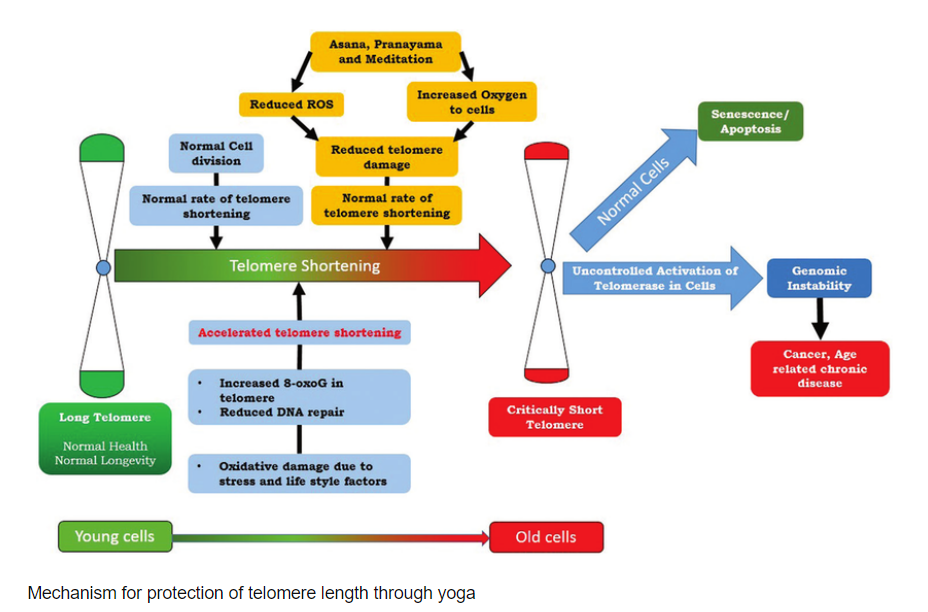
Yoga reduces the inflammatory response that causes stress and can even reverse stress-related damage to the genes. This also means that you don’t pass on your stress issues to your children.
#9. Yoga heals and evolves you
One thing is to manage stress and the other is to change your perception toward whatever is causing you stress and stop conceiving it as a stressor. Now, THAT is a game changer!
Yogis do this by embracing the core principles of Yoga philosophy – ‘the dual nature of the material world’ and ‘the impermanence of the material world’ being the most important ones.
Why?
The fundamental reason we get stressed is that we are either disturbed by or attached to, someone or something. We translate these two things as a ‘difficult situation’ causing stress.
So, for example, your finances are causing you stress. Take a look at your choices. Are you too attached to living a certain way? Is this really what you want or are your choices a result of ‘competition’ with your peers or ‘peer pressure’?
If they are your choices and you want to continue with those, then you must look at the stress as a challenge towards fulfilling your choices. But if they are not your choice, you can start making different choices gradually to relieve the pressure off you.
You can apply this understanding to everything in life, be it work, relationships, or a traumatic event.
Recognizing the intrinsic impermanence or ‘limited nature’ of everything in your life can truly set you free. You stop being attached to or being disturbed by anything too much and learn to draw boundaries in your mind.
Then, you will start healing and evolving! You will start being a part of the bigger scheme of things, the bigger plan.
A lot of Yoga techniques like Yognidra, meditation, and even Asanas can prepare your mind to live life with such awareness, each moment.
What type of Yoga is best for stress relief?
Most of us understand Yoga as Asanas (yoga poses) only. It is natural as we are more identified with the body and can relate to a body practice much more easily.
So, as you start practicing Yoga with Asanas, choose slow and gentle styles of Hatha over fast-paced and intensive movements as in Ashtanga and Vinyasa.
That is because the body and mind are connected. Most importantly, research suggests that this connection is built into the brain. It means that how we conduct our body directly affects the mind.
So, faster movements with an aggressive attitude make the mind overanalytical (thoughts with a lot of speed) and egoistic (aggression). Mindful movements with a peaceful attitude keep the mind calm and gentle – a quality you need to tackle stress.
Even all the research we saw also shows that Hatha Yoga is the most beneficial for stress relief. So, you must practice Asanas in the Hatha Yoga style, i.e., hold a pose for 5 to 10 breaths and even longer for up to 3 minutes, gradually increasing your endurance level.
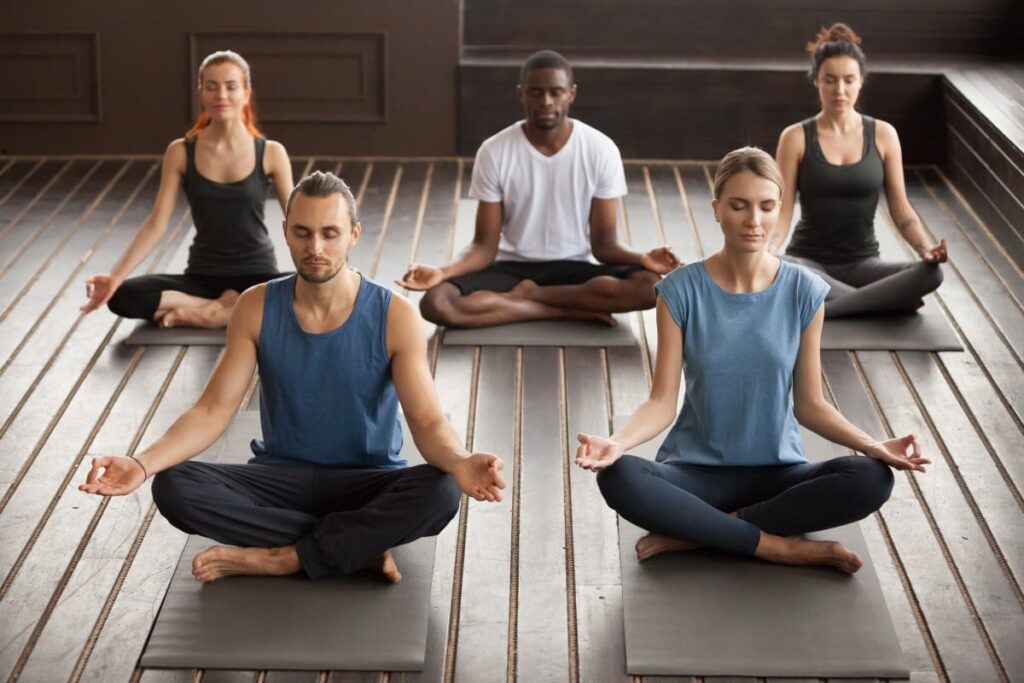
Also, you must never choose random poses off the internet for stress relief, but always a proper sequence. An Asana sequence ensures that your body and mind come to a balance at the end of the practice.
There are 7 more techniques of Hatha Yoga other than Asanas, and you will discover them as you advance in your practice.
Along with Hatha Yoga, some of the best Yoga practices for stress relief are:
- Karma Yoga – Purification of the mental tendencies
- Mantra chanting – Mantra chanting is a powerful tool to get rid of stress and depression. It is part of Bhakti Yoga or devotion that results in fine tuning and crystallization of the mental tendencies. It is a form of concentration and makes the mind ready for meditation.
- Yognidra – A psychic practice taken from the tantras, also known as the ‘sleepless sleep’. Ideal for people who need a kickstart in terms of stress relief and the mental structure required to start any kind of practice. Yognidra is even more transformative for the advanced practitioners of Yoga to go into spiritual depths.
Let’s start practicing with a proper Yoga sequence especially put together for stress relief.
Sequence of Yoga poses for stress relief
It is best to do Yoga on a Yoga mat and there are amazing choices online. Pick up the one you like, made out of environment-friendly material, and start.
Sit in a comfortable cross-legged posture, and close your eyes. Keeping the spine straight, roll your shoulders back and relax. Bring your awareness to the breath – inhalation and exhalation.
Bring both palms together into Namaskar Mudra.
Take a deep breath in, and as you exhale, bring about a feeling of surrender in your heart. Inhale again and as you exhale, let go of all the controlling thoughts and emotions. Acknowledge your existence in a bigger scheme of things, and realize the unique part you play in it.
One more breath – inhale, and exhale, and relax completely.
Now, just be aware of the breath coming in and going out for about ten sets. Then come up on top of your Yoga mat, and begin.
Note: Each posture should be held for at least 5 breaths (inhalation and exhalation). You can extend it to up to 10 breaths or even up to 3 minutes.
#1. Tree Pose or Vrikshasana – balance while sharpening focus

- Stand with your feet together, shoulders rolled back, and core engaged.
- Plant your right foot firmly on the ground by stretching your toes slightly apart.
- Bend your left leg and place its sole on the right thigh, toes facing down, and heel towards the pelvis.
- Keep the heel as close to the pelvis as possible and the grip firm. Make sure that the left knee is completely facing towards the left side and not pointing to the front.
- Choose a point of focus in front and become stable.
- Once you find your balance, bring the palms together into namaskar, and stretch them over and above your head with elbows straight.
- Keep the focus to maintain the balance or you can also try closing your eyes.
- Maintain the awareness of breath for 5 rounds, then exhale and carefully come out of the posture.
- Repeat on the other side.
#2. Extended Triangle or Trikonasana – energizing and cleaning of the lungs
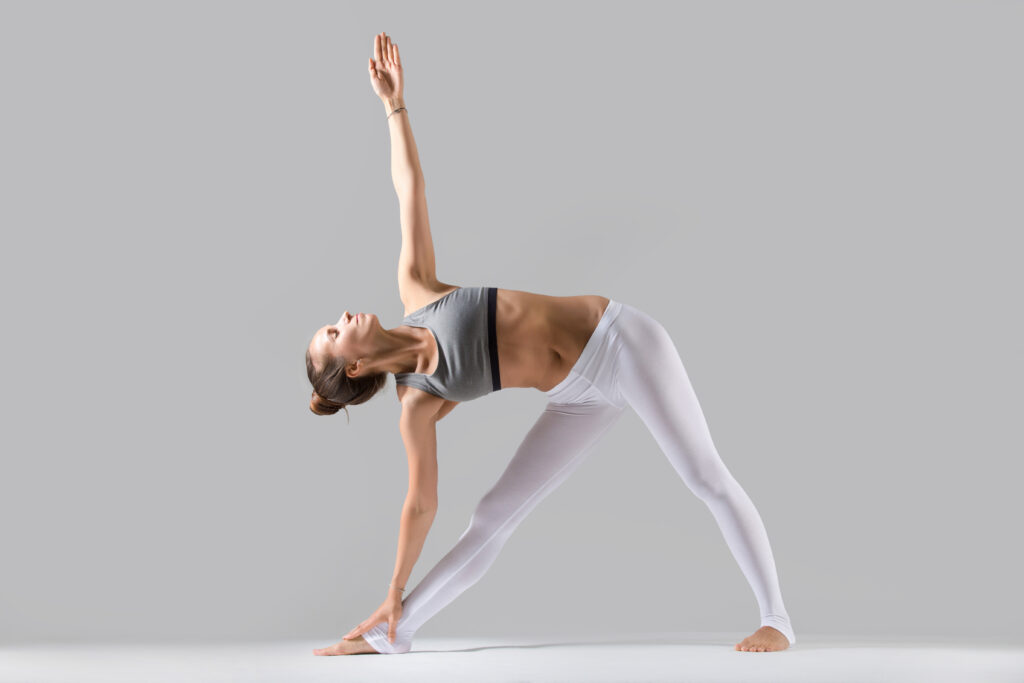
- Stand with the legs apart at 3 to 4 feet distance. Find the balance between the two feet without leaning on either. In case you feel any pain in the knees or heels, reduce the distance.
- Make sure that the heel of the right foot is in line with the arch of the left foot.
- The body should not turn towards the right, but keep facing the front. Engage the core and tuck in the tailbone of the spine. Keep the hips facing front and not going toward the right.
- Inhale and bring both the arms up parallel to the ground, palms facing down
- Start exhaling and as you exhale, extend completely from the waist towards the right and bend down from the waist.
- Place the right palm on the right leg where comfortable without folding forward. Extend the left arm up, at a 90-degree angle
- Gaze towards the thumb of the left hand
- Use the grip to draw yourself away from the ground reaching for the sky and opening your chest and shoulders.
- Maintain the awareness of breath for 5 rounds, then exhale while bending the right knee and carefully come out of the posture.
- Repeat on the other side.
#3. Warrior – leaving the victim mentality behind
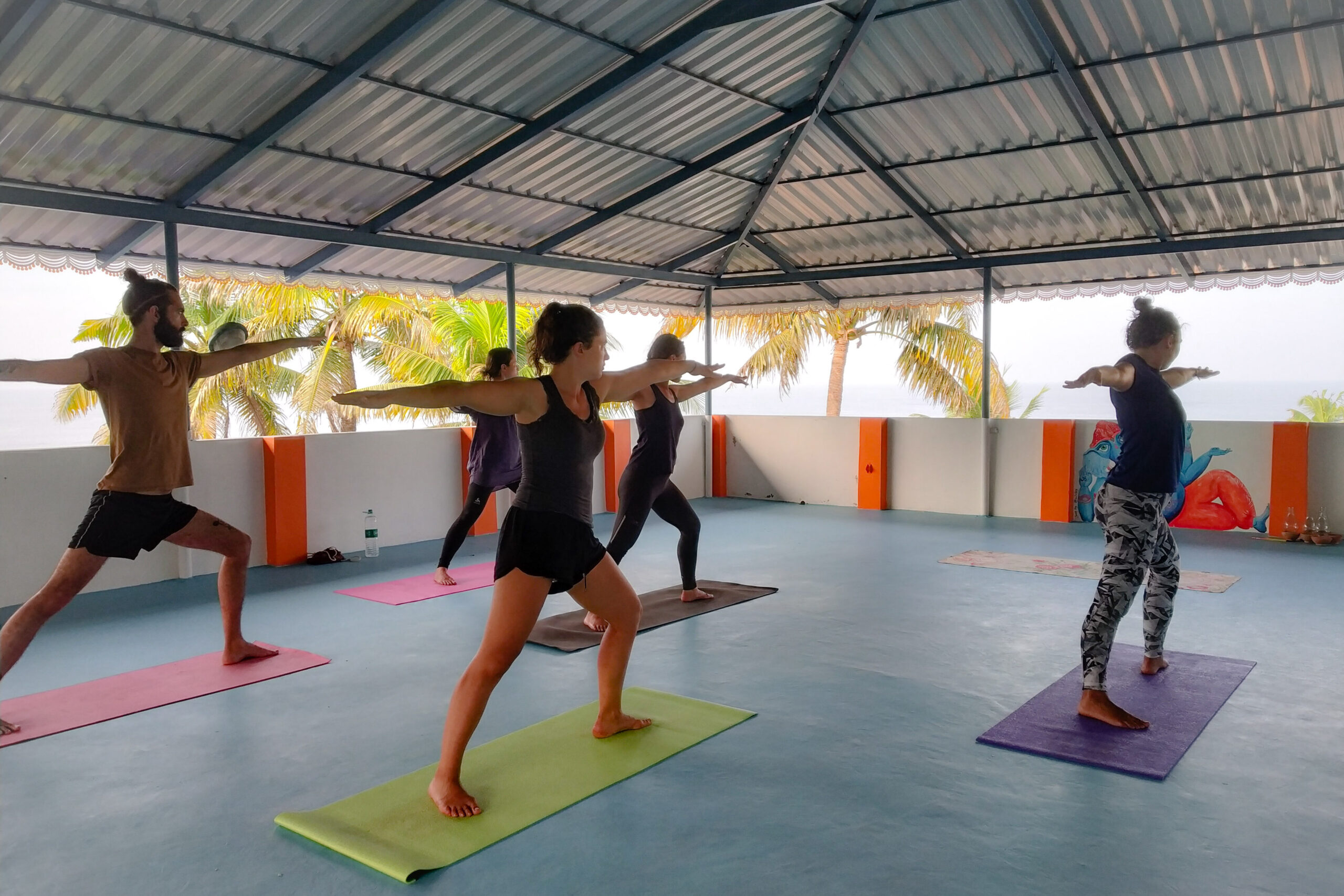
- Stand with the legs apart at 4 to 5 feet distance. Find the balance between the two feet without leaning on either. In case you feel any pain in the knees or heels, reduce the distance.
- Turn the right toe towards the right 90 degrees, right heel in line with the arch of the left foot
- The body should not turn towards the right, but keep facing the front. Engage the core and tuck in the tailbone of the spine. Keep the hips facing front and not going toward the right.
- Inhale and bring both the arms up parallel to the ground, palms facing down
- Exhale, bend the right knee bringing it in line with the ankle, and look towards the middle finger of the right palm.
- Keep pressing the right heel on the mat and consciously stretch both arms away from each other.
- Maintain the awareness of breath for 5 rounds, then exhale and carefully come out of the posture.
- Repeat on the other side.
#4. Hasthottanasana – learning to surrender and letting go
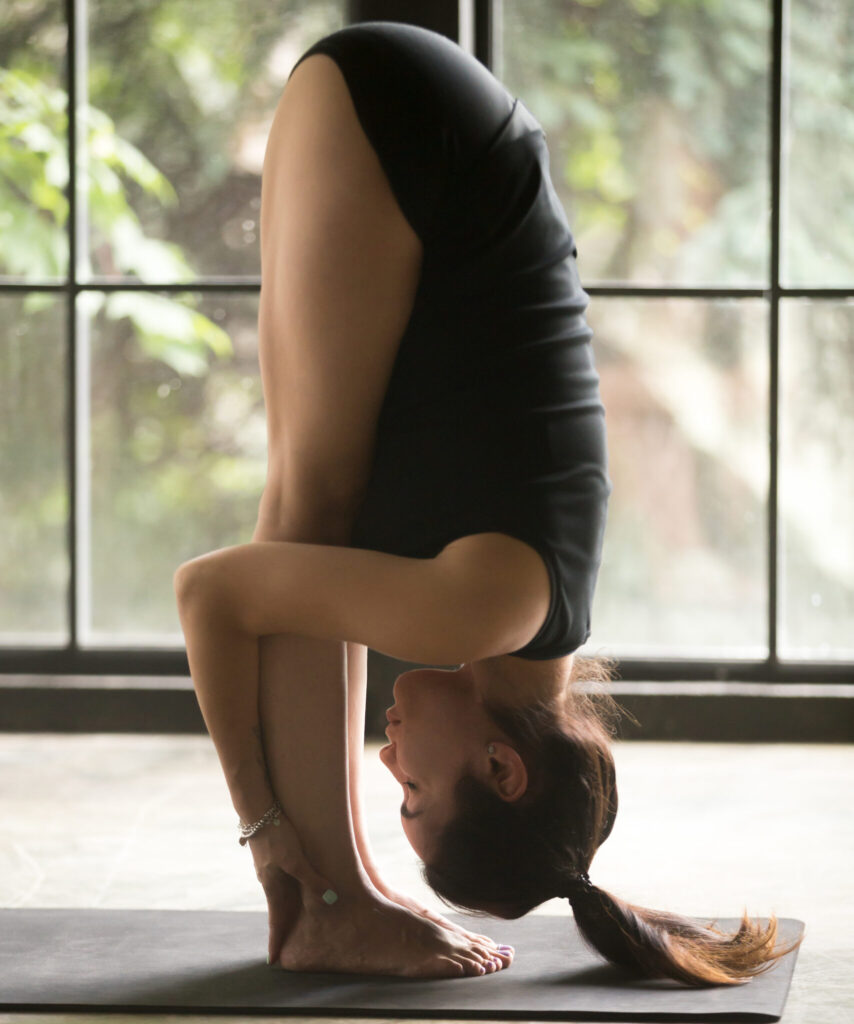
- Inhale, raise both arms with palms facing forward. Keep stretching your spine up as you inhale.
- Exhale, and fold forward bending from the hips. Take a grip on your feet where comfortable.
- Inhale again where you are, and exhale while deepening the forward bend. Repeat this one more time while bringing about the feeling of complete surrender.
- Gaze down in front of feet or gaze back in between the legs
- Engage the thighs and draw kneecaps up
- Make sure that first the stomach touches the thighs and then the chin touches the knees. If you cannot achieve this, stay where you are and keep looking towards the toes.
- Maintain the awareness of breath for 5 rounds, then bend the knees, inhale and carefully come out of the posture.
#5. Anjaneyasana – opening the heart
- Come on all fours on the ground—knees and palms—wrists in line with the shoulders and knees in line with the hips.
- Bring the right leg forward and place the foot between the palms, left knee on the ground, toe relaxed.
- Sit up and lift the left ankle gradually sliding the left leg back to the point where you do not feel any pressure at all on the left knee.
- Inhale and stretch both arms up, fingers pointing to the sky, or bring the palms together in Namaskar Mudra.
- Roll the shoulders back and bend back slightly, bringing the bend from the upper back, opening the chest to the maximum. Look up or in front.
- Maintain the awareness of breath for 5 rounds, then exhale and carefully come out of the posture.
- Repeat from the other side and then relax in the child pose.

#6. Bhujangasana – strengthening the stress response system
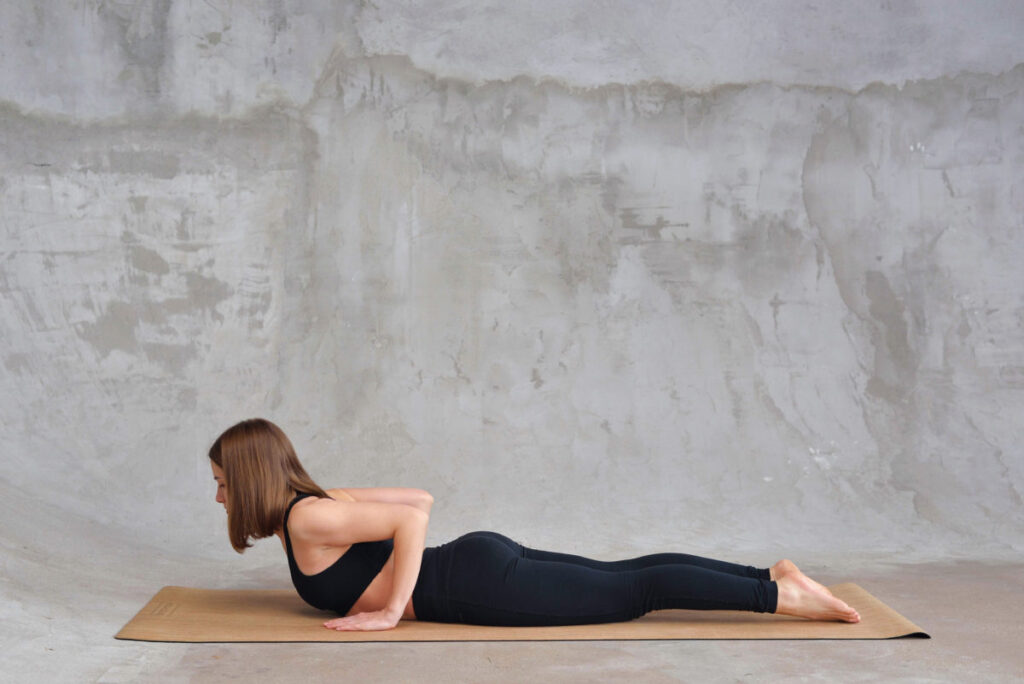
- Lie down on your stomach
- Bring the forehead on the ground and palms facing down by the side of the body, just below the rib cage.
- Turn the elbows towards the body
- Bring the toes and heels together
- Before going into the pose, Inhale deeply and exhale completely. Repeat for one more breath.
- As you inhale the third time, slide forward up, open your chest, and curl yourself up in a backbend. The belly button is on the ground. Engage the core and glutes to lengthen the spine and make sure that heels are together for the entire duration of the asana. Gaze slightly up.
- Maintain the awareness of breath for 5 rounds, then exhale and carefully come out of the posture.
- Make a pillow of your palms and place your forehead, cheek, on chin on the palms. Bring the toes together and heels apart, and relax. This is called Makarasana or the crocodile pose.
#7. Shalabhasana – strengthening the lungs

- Keep lying down on your stomach
- Bring the chin on the ground and rolling from side to side, bring both arms completely under the body, palms facing down. You can also keep the palms facing up, or interlock the fingers to make a fist – whatever feels comfortable and gives you a good lift.
- Keep the legs apart hip-width distance
- Before going into the pose, Inhale deeply and exhale completely. Repeat for one more breath.
- As you inhale the third time, keeping the chin on the ground, bring both your legs up, thighs up, and even your pelvis up.
- Hold your breath here for as long as you can. You can increase from 10 counts to up to 45 seconds or more, depending on your lung capacity.
- Exhale and with control come out of the pose. Lie down in Makarasana, the crocodile pose.
#8. Pawanmuktasana – strengthening the digestive system
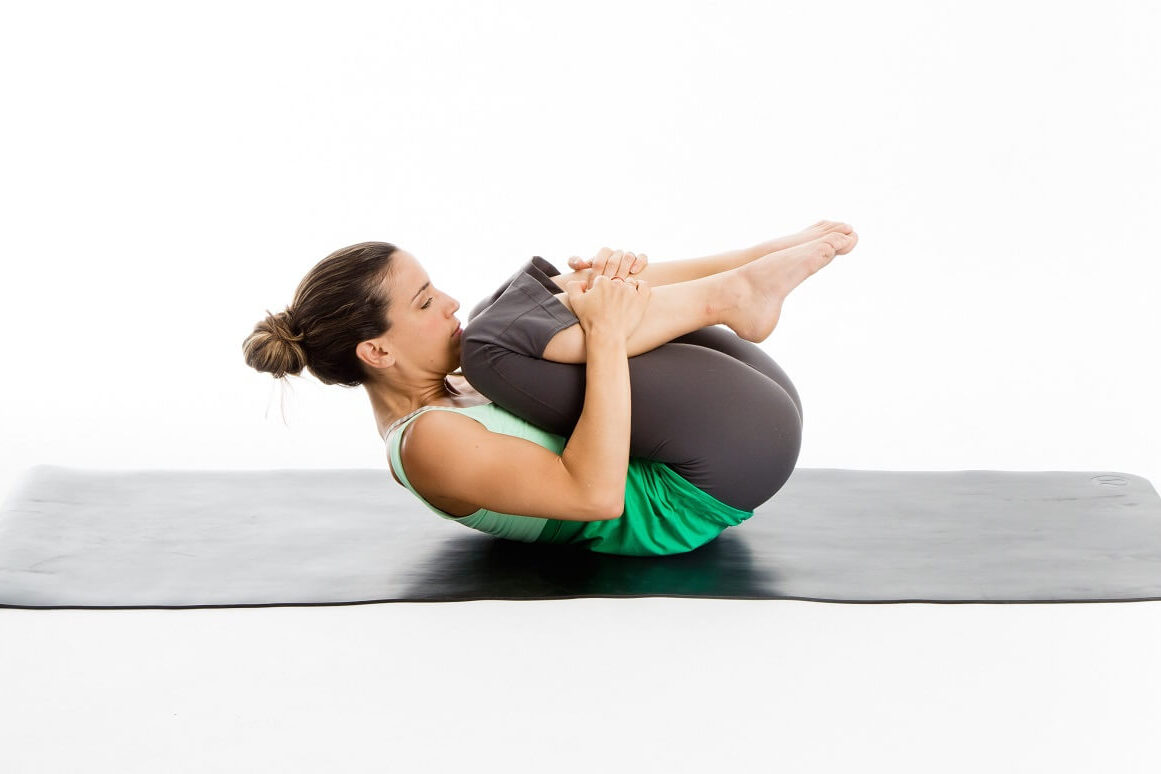
- Roll onto one side and lie down on your back.
- Fold both the legs and bring the knees to the chest.
- Hold both the legs nicely with both the arms around them.
- Once the grip is firm, inhale deeply and start exhaling and at the same time folding forward, trying to bring your chin in between the knees.
- Maintain the awareness of breath for 5 rounds, then inhale/exhale and carefully come out of the posture.
#9. Shavasana – letting your hidden potential release

- Keep lying down on your back. Bring the legs apart so that the thighs are not touching each other.
- Bring the arms apart so they are not touching the chest wall. Palms facing upwards.
- Tuck in the chin slightly so that the back of the head is on the floor.
- Inhale deeply and exhale completely. Do this 2 more times.
- Start moving your awareness from the lower extremities of the body to the head.
- Become aware of your toes, ankles, lower legs, calf muscles, knee caps, whole of thighs, hips, pelvic floor, the whole pelvis.
- Become aware of the fingers, both palms, forearms, elbows, upper arms, the shoulder, armpits.
- Become aware of the back of the neck, the front of the neck, the lower jaw, the chin, both the lips, the left cheek, the right cheek, the left ear, the right ear.
- Become aware of the tongue, the tip of nose, the bridge of nose, the left eye, the right eye.
- The whole of forehead, back of head, sides of head, the top of head.
- Get up when you feel like it.
Once you are ready to get up, bring your feet together, interlock the fingers, and stretch your arms over and above the body on the ground. Inhale and give a good stretch to the body, stretch, stretch, stretch!!
Open the eyes, roll onto one side, and sit up in a comfortable cross-legged posture.
Bring your palms into Namaskara Mudra and inhale deeply. As you exhale, chant Om. Repeat 3 to 9 times.
Breathing exercises for stress management
Yogis know that the mind and body are directly connected. But don’t take their word for it. Simply observe.
Observe as you become angry, how is your breath? If it changes when you calm down. Observe how is your breath when you are deeply concentrated on something – a good book, a maths problem, anything that grabs your attention completely.
Observe your breath in different aspects of life, and you will see, it changes with each mental shift.
No wonder then that deep breathing is the ultimate tool for immediate relief in a panic attack or episodes of anxiety. In fact, tactical breathing used by the Navy, the military, and athletes to focus, gain control, and manage stress is nothing but a pranayama.
Known as Anulom Vilom, it is the safest pranayama practice of Hatha Yoga. It trains the mind to remain balanced in favorable as well as adverse situations like stress.
Let us practice it now.

For Anulom Vilom or alternate nostril breathing practice, sit in a comfortable cross-legged posture with your spine straight. If you cannot sit on the ground or cross-legged, sit on a chair with your spine straight.
Put the thumb of your right hand on the right nostril, leave the index and middle finger, and put the ring finger on the left nostril. Do not use the little finger.
While closing your right nostril, start exhaling from the left, 1-2-3-4-5-6, as long as it takes you to let the breath out completely.
Now, start inhaling from the left nostril, 1-2-3-4, close it with the ring finger, and exhale from the right nostril, 1-2-3-4, or up to 6 to 8 counts depending on your capacity. Inhale from right (4 counts/ seconds) and exhale from left (4-6-8 counts/ seconds). This makes one round – starting with inhalation.
The inhalation and the exhalation should be slow and controlled.
Repeat the process to complete 5-10 rounds.
There are many such breathing techniques in Yoga. The key is to practice them under the guidance of a qualified and experienced Yoga teacher.
Remember, it is of utmost importance to keep your lungs healthy for better breathing and resulting stress management. So, you must also let go of the habits that hamper lung health like overeating, smoking, and being short-tempered.
This brings me to the last section of this article, which also is the most important one.
Lifestyle changes to remain stress-free
As an experienced Yoga practitioner and therapist for 7 years, if I have to answer the question, ‘What is yoga therapy for stress’ in two words, I would say – right lifestyle.
When I say lifestyle, it includes diet, daily routine, and your ‘tendency’. Let’s understand these in detail.
#1. Diet
Nutritional psychology has proved that your food is directly linked to your happiness. the microbes in the gut produce neurotransmitters. These transmitters like dopamine and serotonin influence mood, pain sensitivity, and brain development.
Yoga goes many steps ahead and says each and everything you eat becomes a part of your psyche and affects every aspect of you – body and mind. At the same time, it will either add to your energy, drain it, or fill your stomach without adding or subtracting anything from the energy.
So, for people who would like to maintain high energy, a Sattvik diet is suitable. It is a selective vegetarian diet that also keeps the mind clear with a positive outlook.

Fasting also has great importance in the Yogic lifestyle. The Yogic way of taking meals is ‘Mitahara’, i.e., moderate eating. It includes eating twice a day at an 8-hour interval – the discipline known as intermittent fasting in the modern world.
Most experienced Yoga practitioners also fast twice every month during a specific period.
Why?
Science has confirmed that among all anti-aging interventions, calorie-restricted diets and periods of fasting are the most effective. They also enhance your overall health by reducing the risk of diabetes, neurodegeneration, autoimmune disorders, tumors, and cardiovascular diseases.
So, the science of Yoga is based on solid principles including the aspect of diet. It is just that modern science is discovering it now.
If you are serious about living a life without any stress, you must take baby steps towards modifying your diet accordingly.
#2. Daily routine
Yoga and Ayurveda suggest that you should be up early in the morning, ready to welcome the first rays of the sun.
Also, all seasoned Yoga practitioners follow the Mitahara way of eating, once at about 10-11 a.m. and then finishing off by 6-7 p.m. They retire by 9-9:30 p.m. so they can get up early in the morning.
Why?
Waking up, sleeping, and eating in tune with the sun’s cycle can have an immense effect on you. It affects your physiology, energy levels, moods, and even goal achievement!
An irregular circadian rhythm is a schedule in conflict with the sunlight and subject to everyday change. This kind of schedule can be more dangerous than you think.
An irregular circadian rhythm can have a negative effect on a person’s ability to sleep and function properly. It can also result in a lot of health problems, like depression, anxiety, bipolar disorder, and seasonal affective disorder.
So, conforming to the natural circadian rhythm of the body should be one of your goals for stress management and relief.
#3. Your moment-to-moment predispositions
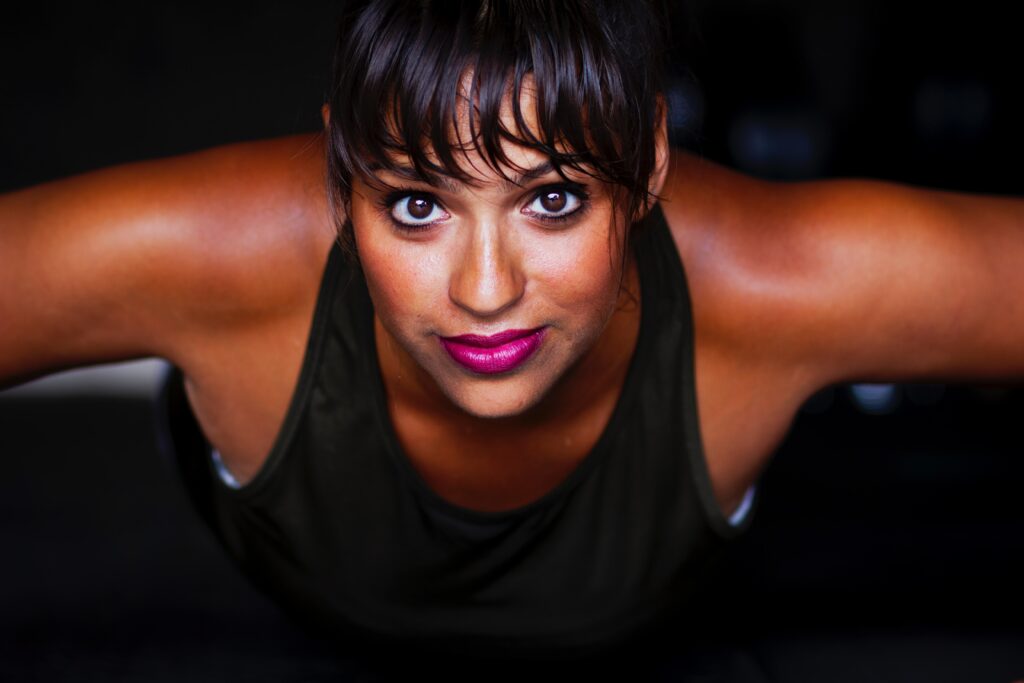
Life is made up of small moments. It is these moments that define the quality of our life.
If you are aware in each moment and have a tendency to look at things positively, chances are, you will become wholesome. If you are sleeping through life and have a tendency to look at things negatively, chances are, you will make your life a living hell.
So, your moment-to-moment predispositions or ‘tendencies’ are extremely important. Fortunately, you can keep them positive by maintaining a few disciplines:
- Right diet – Sattvik diet (write a small post on SRT diets) keeps the mind calm and positive.
- The company you keep and the conversations you participate in.
- Conversation starts with your thoughts. So, be aware of your negative self-talk towards yourself, others, or life in general. Turn it into a positive.
If you can do this, you have won the game of life, including a mind that knows how to deal with stress.
Making mindful choices should be your number 1 priority for stress management and relief.
Conclusion
Stress may be the longest ongoing pandemic of our time but it cannot touch you if you use the right tools.
Yoga is not a temporary solution to stress, it is a life skill that trains you not just to handle stress but to live a more fulfilling life. A life where you create a wholesome existence for not just yourself but for every being around you.
So, start bringing Yoga into your life with the directions given in this post.
You can also sign up for my online workshop here, or feel free to get in touch with me for in-person classes or ad-hoc group classes.
It is time to build a new world free of stress that is happier, healthier, and more inclusive, and I am counting on each one of you to participate!
